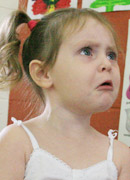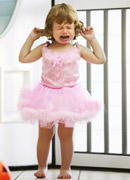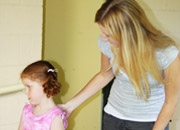Behaviour
Caring for babies
Bottle feeding
Changing a nappy
Cleaning and sterilising bottles
Daily cleaning tasks
Helping new children settle in
Preparing for a nappy change
Sleep patterns – babies
Sleep routines – babies
Toilet training
Caring for children
Allowing time for practice
Dressing/undressing
Mealtimes
Nappy change
Packing away/caring for the environment
Sleep/rest time
Toileting
Common self-help milestones
Tips for sleep and rest time
Self image
Communication
Body language
Limits and guidelines
Ways children communicate
Greeting children and families
Modelling appropriate communication
Questioning
Verbal and non–verbal communication
Acknowledging children's feelings
Listening attentively
Communicating with Aboriginal and Torres Strait Islander parents/carers
Development
Allowing time for practice
Dressing/undressing
Mealtimes
Nappy change
Packing away/caring for the environment
Sleep/rest time
Toileting
Common self-help milestones
Creative development
Language development
Modelling positive relationships
Physical development
Sharing and taking turns
Sleep patterns – babies
Sleep routines – babies
Encourage independent problem solving
Fundamental movement skills
Health, hygiene and safety
Coping with stress
Correct manual handling principles
Daily cleaning tasks
Hand washing
Hand washing poster
Manual handling overview
Toilet training
Safety checklist
Learning experiences and play
Environmentally friendly learning experiences
Learning experiences for different development areas
Creative resource materials
Arranging the environment to facilitate learning and pleasure
Indoors and outdoor areas
Creating a positive physical environment
Legal and ethical issues
Child abuse case studies
How do I recognise when a child or young person is at risk?
Tips on dealing with disclosures
Observation methods
Arranging Experiences (PDF 351Kb)
Recording observations
Rules for making observations
What you can learn from observations
Programming
Children’s interests, strengths, needs and skills
Extending the children’s interest in dinosaurs
Objective observation
Planning an OSHC environment
Behavior management plan
Planning enjoyable experiences
Planning experiences for 0 - 2 years age group
Planning experiences for 2 - 3 years age group
Planning experiences for 3 - 5 years age group
Acknowledging children's feelings
To be able to acknowledge children’s feelings, you first need to recognise them. You can do this by paying close attention to clues such as facial expressions, gestures, sounds and other communication from the child.
Recognising children’s feelings
An important part of interacting with children involves the skill of responding to non-verbal cues. Remember, non-verbal communication can make up as much as 70% of the total message being communicated by the child. Described below are the main non-verbal clues that children give.
Facial expressions

Facial expressions are used by most people and allow you to recognise how that person is feeling at the time you see them.
Children, particularly babies and toddlers, will often communicate through their facial expressions as they are still developing their verbal communication skills and ability to speak.
Gesturing, movement and touching

Gesturing, movement and touching are other ways children can indicate their message without using verbal communication. It is particularly useful with toddlers and those children who are not yet speaking.
Sounds
Sounds and noises are mostly used by babies and toddlers when they are trying to get your attention or have their needs met. The sounds and noises can vary from child to child, but with experience you will become more skilled at matching them with specific needs.
Personal space
Personal space refers to each individual's 'boundary', or how physically close they prefer another person to be to them. This is a very personal issue - some people have a small personal space boundary that allows people to get very close to them, even touching. Other people have a large boundary, and prefer that people keep their distance.
Usually, people will allow friends or family members to get closer to them than they would allow a stranger to. In some cases the personal space boundary is determined by the occasion of meeting, in other cases cultural or traditional beliefs may be the guiding ot deciding factor.
Children will be aware of how physically close they like others to get. Look for signals; if the child starts to back away from you, you are getting too close. If you feel uncomfortable about how close a child is to you, then you need to let them know in a compassionate way.
Below you can see two children of different ages with their carer. Using your mouse, move the carer along each point in the line towards the child. Watch how the child’s expression changes, as the carer gets closer.
Did you notice that Tim got happier as the carer got closer? Emily, however, started to look uncomfortable as the carer got closer. This example shows how important it is to understand that each child will have their own personal space boundaries, which you will need to discover and respect.
Accepting children's feelings
When acknowledging children's feelings you will need to also accept them. This doesn't mean you need to agree with their feelings, but you need to accept that the way a child feels is important to them. Acknowledging and accepting a child's feelings demonstrates that you are interested in and respectful of how they feel.

Your communication with children should reflect their feelings. This may require you to change your communication style to suit the moment. Sometimes only a pat on the shoulder is necessary - for example if Billy is feeling sad, avoid approaching him with a really happy face as he may think that you are saying he should always be happy. To Billy, this would mean that you are not acknowledging his feelings. Just put your hand on his shoulder and let him know it's okay to be sad sometimes.
Look at the following situations, and click on the response that represents the best way of acknowledging the child's feelings. You will receive feedback on your choice.